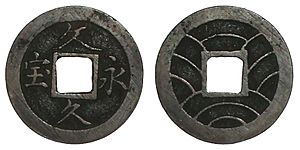Bunkyū facts for kids
The Bunkyū era was a special time period in Japan's history. It was a way of counting years, like how we use 'AD' or 'CE' today. This era lasted from February 1861 to February 1864. During this time, Emperor Kōmei was the ruler of Japan.
What Happened During the Bunkyū Era?
- 1861 (Bunkyu 1): A person named Ukai Gyokusen opened Japan's very first photography studio in a city called Edo (which is now Tokyo). It was named Eishin-dō.
- 1861 (Bunkyu 1): A very bright and famous comet, known as the Great Comet of 1861, was seen in the sky.
- January 1862 (Bunkyū 1, 12th month): The Bonin Islands (also called the Ogasawara Islands) were officially recognized as part of Japan.
- 1862 (Bunkyū 2): Important changes called the Bunkyū Reforms happened. These reforms made life easier for the powerful regional lords, known as daimyo, by reducing strict rules that were put in place earlier.
- 14 September 1862 (Bunkyū 2, 21st day of the 8th month): An event known as the Namamugi Incident took place. Samurai from the Satsuma Province killed a British merchant named Charles Lennox Richardson on the Tōkaidō road near Namamugi.
- 22 April 1863 (Bunkyū 3, 5th day of the 3rd month): The shogun, Tokugawa Iemochi, traveled in a huge parade to the capital city. The emperor had asked him to come, and he had 3,000 of his followers with him for protection.
- 28 April 1863 (Bunkyū 3, 11th day of the 3rd month): Emperor Komei made a special visit to the Kamo Shrines. The shogun and many important lords joined him.
- 15-17 August 1863 (Bunkyū 3, 2nd-4th of the 7th month ): The British navy attacked the city of Kagoshima. This was done to get back at the Satsuma samurai for killing Charles Lennox Richardson.
Related pages
- National Diet Library, The Japanese Calendar -- historical overview plus illustrative images from library's collection
See also
 In Spanish: Bunkyū para niños
In Spanish: Bunkyū para niños

All content from Kiddle encyclopedia articles (including the article images and facts) can be freely used under Attribution-ShareAlike license, unless stated otherwise. Cite this article:
Bunkyū Facts for Kids. Kiddle Encyclopedia.

